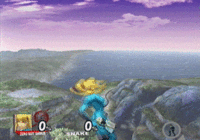| Welcome to SmashWiki! Log in or create an account and join the community, and don't forget to read this first! |
| Notices |
|---|
| The Skill parameter has been removed from Smasher infoboxes, and in its place are the new "Best historical ranking" and "Best tournament result" parameters. SmashWiki needs help adding these new parameters to Smasher infoboxes, refer to the guidelines here for what should be included in these new parameters. |
| When adding results to Smasher pages, include each tournament's entrant number in addition to the player's placement, and use the {{Trn}} template with the matching game specified. Please also fix old results on Smasher pages that do not abide to this standard. Refer to our Smasher article guidelines to see how results tables should be formatted. |
| Check out our project page for ongoing projects that SmashWiki needs help with. |
Auto-canceling
Auto-canceling is the act of landing during the beginning or ending frames of an aerial attack and circumventing the landing lag that would have occurred had the character landed in the middle. Auto-canceling an attack usually produces almost no landing lag, when landing during the middle frames would produce greater landing lag. Most aerial attacks can be auto-cancelled both during the first few frames or the last few frames, though some cannot be auto-cancelled at the start, at the end, or even both. Every attack has a specific auto-cancelling window. Characters that fail to auto-cancel can instead L-cancel (outside of Brawl). Auto-canceling can be very beneficial to players using characters with laggy aerial attacks, as this can reduce the amount of landing lag produced, and create more time for the character to act, potentially avoiding punishment that could have been made if the player had not auto-cancelled.
Trivia
- The forward airs of Donkey Kong and Ganondorf in Brawl cannot be auto-cancelled in the ending frames. By looking at the coding of the moves, it can be seen that they were intended to be, and they cannot due to a minor error of using the wrong type of timing function.


